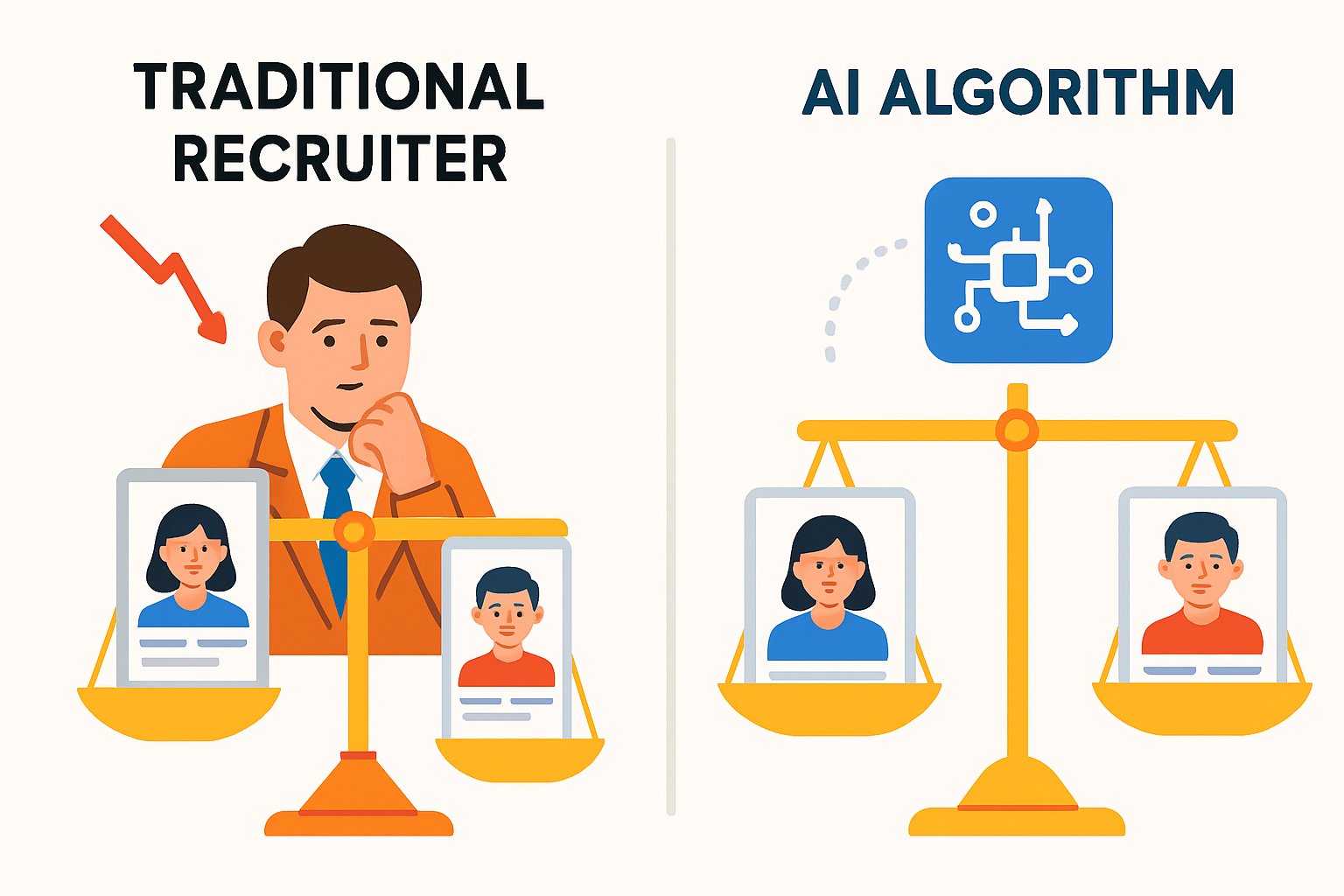
AI CERTS
10 hours ago
Unbiased Hiring: AI Cuts 40% Recruitment Bias
Therefore, technical leaders and talent executives must separate robust findings from hopeful marketing. This review will detail the 40% claim, highlight limitations, and outline verified mitigation approaches. Readers will also find pointers to the AI+ HR™ certification for deeper operational skills.
Evidence Behind 40% Claim
Peer-reviewed studies provide the strongest support for the headline figure. For example, an arXiv interview experiment recorded a 41.2% sentiment bias drop after mitigation. Additionally, an attention-pruning technique reduced a gender metric by roughly 40%. In contrast, vendor case studies supply promising yet less transparent numbers. Therefore, context, metric choice, and sample size determine whether the reduction sticks.

Teams aiming for Unbiased Hiring must scrutinize chosen metrics. Bias metrics vary widely across projects. Researchers compare demographic parity, equalized odds, or disparate impact ratios. Consequently, a 40% improvement in one metric may not translate elsewhere. Nevertheless, consistent downward trends across multiple metrics signal real progress.
The academic record confirms material bias reductions under controlled conditions. However, field deployments still need stronger verification. These insights set the stage for examining regulatory influence.
Regulatory Forces Shape Deployments
Regulators now label AI hiring tools as high-risk systems. Moreover, the EU AI Act mandates transparency, logging, and ongoing bias auditing. Subsequently, vendors must document data sources and explain model outputs. New York City's Local Law 144 extends similar obligations to recruiters operating locally. Consequently, independent auditors increasingly release public summaries of algorithmic performance.
Compliance timelines create urgency for both HR Tech providers and employers. By 2027, full EU compliance will demand documented risk management and human oversight. Meanwhile, early adopters already use audit badges to attract applicants seeking fairness. Therefore, regulation turns Unbiased Hiring from aspiration into contractual requirement.
Policy pressure accelerates adoption of measurable fairness practices. Next, real workplace examples reveal how theory meets reality.
Key Industry Case Studies
Unilever's graduate pipeline illustrates mixed yet instructive outcomes. The company integrated Pymetrics games with HireVue video analysis. Consequently, screening time dropped drastically while reported Diversity increased by about 16%. However, the firm released limited raw audit data, leaving external reviewers cautious.
Historic failures offer critical counterpoints. Amazon abandoned an internal recruiter after discovering gender bias embedded in historical data. In contrast, newer vendors like Applied publish transparent evaluation protocols. Therefore, procurement teams must request bias reports before signing multiyear Recruitment contracts.
Case studies confirm efficiency gains but underscore validation gaps. The next section offers practical mitigation techniques to address those gaps.
Practical Bias Mitigation Strategies
Technical and organizational levers jointly reduce discriminatory outcomes. Moreover, blind screening removes names and photos, reducing unconscious judgment triggers. Structured work samples replace unstructured interviews, thereby promoting objective skill assessment. Fairness-aware training applies adversarial debiasing during model learning. Post-hoc repairs such as attention pruning adjust model weights without full retraining.
Practitioners often combine several tools, as shown below.
- Anonymize resumes to mask demographic indicators.
- Use open benchmarks like FAIRE for ongoing bias tracking.
- Schedule periodic human audits aligned with regulatory calendars.
- Integrate explainability dashboards for recruiter transparency.
Additionally, teams should certify skill sets. Professionals can deepen expertise through the AI+ HR™ certification. Certification holders gain frameworks for governance, model selection, and continuous fairness monitoring.
Each tactic contributes incrementally toward Unbiased Hiring when combined thoughtfully. Combined mitigations often outperform single techniques. However, measuring impact accurately remains essential. The following section discusses measurement challenges and limitations.
Measuring Impact And Limits
Bias reduction claims depend on reliable baselines. Researchers must disclose datasets, demographic splits, and confidence intervals. Therefore, replication studies such as FAIRE are critical for community trust. Nevertheless, live deployments expose shifting applicant pools and adversarial behaviors. Consequently, field performance can drift away from lab benchmarks.
Vendor marketing often omits metric definitions. In contrast, academic publications publish full protocols and code. HR Tech buyers should request standardized demographic parity reports before purchase. Moreover, quarterly re-audits catch model drift early. Detailed Recruitment analytics simplify cross-site comparisons.
Continuous monitoring keeps Unbiased Hiring performance aligned with original audit results. Accurate measurement guards against complacency. Next, expert analysis clarifies remaining knowledge gaps.
Expert Opinions And Gaps
Industry leaders highlight efficiency and reach. Kevin Parker of HireVue notes automation expands applicant pools beyond traditional schools. Meanwhile, scholars like Soleimani emphasize collaboration between HR professionals and data scientists. Nevertheless, both groups agree transparency remains unfinished business.
Major gaps involve longitudinal field evidence and disabled applicant accessibility. Furthermore, few studies examine intersectional outcomes across race, gender, and age simultaneously. Consequently, journalists continue pressing vendors for open audits.
Experts caution that Unbiased Hiring demands persistent cross-functional vigilance. Stakeholders recognise progress yet demand deeper evidence. Finally, action plans help leaders operationalize insights.
Action Plan For Leaders
Executives should adopt a phased roadmap. Firstly, map hiring stages and associated bias metrics. Secondly, select vendors with published audits and EU AI Act alignment. Thirdly, train recruiters in fairness concepts and tool usage. Finally, schedule annual independent audits, publishing summaries for applicants.
- Define fairness objectives aligned with corporate Diversity goals.
- Evaluate HR Tech vendors using standardized scorecards.
- Enroll leaders in the AI+ HR™ program.
- Monitor live metrics, adjusting models when drift appears.
Moreover, communicating Unbiased Hiring commitments attracts values-driven talent. Consequently, fair processes reinforce employer branding while reducing legal risks.
Structured action closes the gap between research and day-to-day operations.
AI recruitment tools can materially shrink early-stage bias when designed, audited, and monitored rigorously. Academic studies, regulatory mandates, and selective vendor practices point toward a maturing fairness ecosystem. Nevertheless, evidence remains heterogeneous across sectors, geographies, and protected groups. Consequently, leaders should prioritize transparent metrics, continuous audits, and multifaceted mitigation. By championing Unbiased Hiring, organizations unlock broader talent pools, strengthen Diversity, and reduce legal exposure. Take the next step by exploring the AI+ HR™ certification and advancing responsible Recruitment practices.



